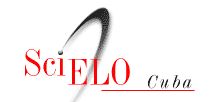Factores de riesgo de neumonía asociada al ictus: cohorte prospectiva de estudio
Resumen
Objetivo: determinar los factores de riesgo para pronosticar neumonía asociada al ictus.
Métodos: se realizó un estudio observacional analítico de cohorte única prospectiva en 390 pacientes con criterios clínicos y de neuroimagen de ictus agudo, con edades comprendidas entre 16 y 93 años de edad, admitidos en el Hospital Carlos Manuel de Céspedes desde enero 2012-marzo-2015. La comparación univariante de las variables cualitativas se realizó mediante uso de tablas de supervivencia de Kaplan-Meier, se empleó el modelo de regresión de Cox para el análisis multivariante de los factores de riesgo de neumonía, el área bajo la curva ROC se utilizó para determinar el poder de discriminación del modelo.
Resultados: se estudiaron 213(54,6 %) pacientes con ictus isquémico y 177(45,4 %) con ictus hemorrágico. La totalidad de casos con neumonía intrahospitalaria tras el ictus agudo fue de 25, 4 %. Los sujetos que desarrollaron neumonía tenían menor puntuación en la escala de Glasgow y una alta puntuación en la escala modificada de Rankin. Se identificaron los siguientes factores de riesgo mediante regresión de Cox: puntuación de Glasgow (Exp (B): 0,687; IC 95% 0,630 a 0,750) y el subtipo de ictus (Exp (B): 1,723; IC 95% 1,137 a 2,610); el área bajo la curva ROC fue de 0,88.
Conclusiones: los factores de riesgo que favorecen la aparición de neumonía intrahospitalaria en pacientes con ictus agudo son: el deterioro del nivel de conciencia, unido a la variedad hemorrágica del ictus. Otras variables con influencia fueron: la enfermedad pulmonar obstructiva crónica y la enfermedad cardiaca como comorbilidad.
Palabras clave
Referencias
- Kumar S, Selim MH, Caplan LR. Medical complications after stroke. Lancet Neurol. 2010;9(1):105-18.
- Ji R, Wang D, Shen H, Pan Y, Liu G, Wang Y, et al. Interrelationship among common medical complications after acute atroke: pneumonia plays an important role. Stroke. 2013;44(12):3436-44.
- Heikinheimo T, Broman J, Haapaniemi E, Kaste M, Tatlisumak T, Putaala J. Preceding and poststroke infections in young adults with first-ever ischemic stroke: effect on short-term and long-term outcomes. Stroke. 2013;44(12):3331-7.
- Chumbler NR, Williams LS, Wells CK, Lo AC, Nadeau S, Peixoto AJ, et al. Derivation and validation of a clinical system for predicting pneumonia in acute stroke. Neuroepidemiology. 2010;34(4):193–9.
- Westendorp WF, Nederkoorn PJ, Vermeij JD, Dijkgraaf MG, van de Beek D. Post-stroke infection: A systematic review and meta-analysis. BMC Neurol. 2011;11(1):1-7.
- Sellars C, Bowie L, Bagg J, Sweeney P, Miller H, Tilston J, et al. Risk factors for chest infection in acute stroke. Stroke. 2007;38(8):2284-91.
- Li Y, Song B, Fang H, Gao Y, Zhao L, Xu Y. External validation of the A2DS2 score to predict stroke-associated pneumonia in a Chinese population: a prospective cohort study. Plos One. 2014;9(10):e109665.
- Winklewski PJ, Radkowski M, Demkow U. Cross-talk between the inflammatory response, sympathetic activation and pulmonary infection in the ischemic stroke. J Neuroinflammation. 2014;11(1):213.
- Westendorp WF, Nederkoorn PJ, Vermeij JD, Dijkgraaf MG, van de Beek D. Post-stroke infection: a systematic review and meta-analysis. BMC Neurol. 2011;11(1):110.
- Pandian JD, Kaur A, Jyotsna R, Sylaja PN, Vijaya P, Padma MV, et al. Complications in acute stroke in India (CAST-I): a multicenter study. J Stroke Cerebrovasc Dis. 2012;21(8):695-703.
- Suárez A, López E, García N, Serra MA. Predictores clínicos de neumonía intrahospitalaria asociada al ictus isquémico agudo. Finlay[Internet]. 2015[citado 2 Jul 2015];5(2):[aprox. 7p.]. Disponible en: http://revfinlay.sld.cu/index.php/finlay/article/view/359.
- Suárez A, García N. Predictores de neumonía nosocomial precoz en pacientes con hemorragia intracerebral espontánea. Multimed. 2015;19(3):1-14.
- García E, Hernández A, Herrero JA, Gómez J. Protocolo terapéutico empírico de la neumonía nosocomial. Medicine. 2014;11(56):3330-2.
- Perry L, Love CP. Screening for dysphagia and aspiration in acute stroke: a systematic review. Dysphagia. 2001;16(1):7-18.
- Zhang X, Wang F, Zhang Y, Ge Z. Risk factors for developing pneumonia in patients with diabetes mellitus following acute ischaemic stroke. J Int Med Res. 2012;40(5):1860-5.
- Harms H, Grittner U, Droge H, Meisel A. Predicting post-stroke pneumonia: the PANTHERIS score. Acta Neurol Scand. 2013;128(3):178-84.
- Li Y, Song B, Fang H, Gao Y, Zhao L, Li Y, et al. Risk factors for stroke-associated pneumonia in a Chinese population: a prospective cohort study. Life Sci J. 2014;11(6):378-82.
- Ji R, Shen H, Pan Y, Wang P, Liu G, Wang Y, et al. Novel risk score to predict pneumonia after acute ischemic stroke. Stroke. 2013;44(5):1303-9.
- Chen LF, Chang CY, Hsu LC, Tsai PH, Chang SJ, Chang SC, et al. Bacterial pneumonia following acute ischemic stroke. J Chin Med Assoc. 2013;76(2):78-82.
- De Raedt S, De Vos A, Van Binst AM, De Waele M, Coomans D, Buyl R, et al. High natural killer cell number might identify stroke patients at risk of developing infections. Neurol Neuroimmunol Neuroinflamm. 2015;2(2):e71.
- Liesz A, Dalpke A, Mracsko E, Antoine DJ, Roth S, Zhou W, et al. DAMP signaling is a key pathway inducing immune modulation after brain injury. J Neurosci. 2015;35(2):583-98.
- Folyovich A, Biró E, Orbán C, Bajnok A, Varga V, Béres AK, et al. Relevance of novel inflammatory markers in stroke-induced immunosuppression. BMC Neurol. 2014;14(1):41.
- Maramattom BV, Weigand S, Reinalda M, Wijdicks E, Manno EM. Pulmonary complications after intracerebral hemorrhage. Neurocrit Care. 2006;5(6):115-9.
Enlaces refback
- No hay ningún enlace refback.
FINLAY EN: 








FINLAY CERTIFICADA POR:

Esta revista "no aplica" cargos por publicación en ninguna etapa del proceso editorial.
Dirección postal: Calle 51A y Avenida 5 de Septiembre Cienfuegos, Cuba Código postal: 55100.
http://www.revfinlay.sld.cu
Telefono: +53 43 516602. Telefax: +53 43 517733.
amgiraldoni@infomed.sld.cu
ISSN: 2221-2434
RNPS: 5129






